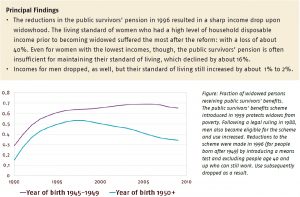Financial Consequences of Widowhood
“Further reductions in the public survivors’ pension could lead to a significant income drop for recipients”
The need for providing public survivors’ benefits is under discussion in light of the fact that more women are working and there are now more possibilities for securing insurance against income loss. This study focused on the drop in income for various groups in the event of widowhood. To what extent are people in a position to cover this themselves? We analyzed the reductions in the survivors’ pension brought about by implementation of the Surviving Dependents Act (ANW) in 1996 and the consequences of that in light of the new pension agreement.

Key Takeaways for the Industry
- Policymakers could consider integrating the survivors’ benefits of the first and second pillars, for example, by introducing benefits for three to five years of 70% of the income of the deceased partner and 100% if they have minor children.
- Basing benefits on the income at the time of death promotes workforce participation, and making the benefits temporary provides an incentive to work more.
Want to know more?
Read the paper of Jeroen van der Vaart¹, Rob Alessie¹, and Raun van Ooijen¹,² – ¹RUG; ²UMCG “Economic consequences of widowhood: Evidence from a survivor’s benefits reform in the Netherlands”


